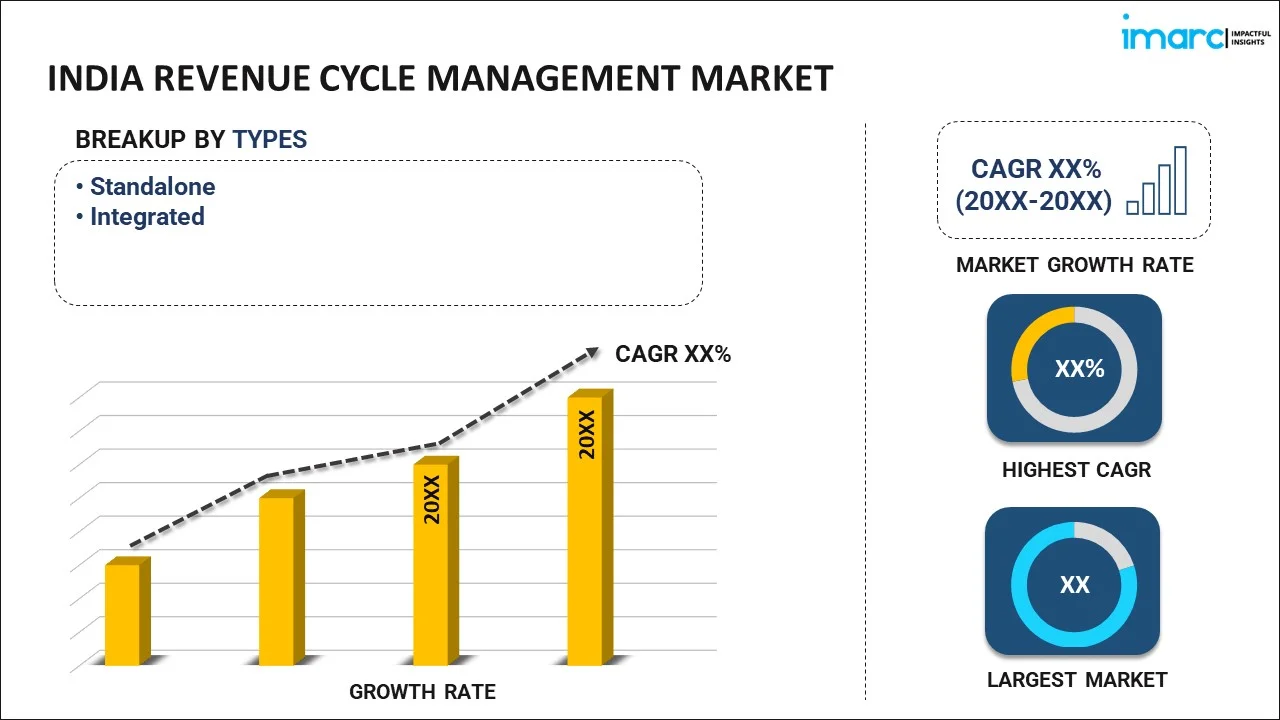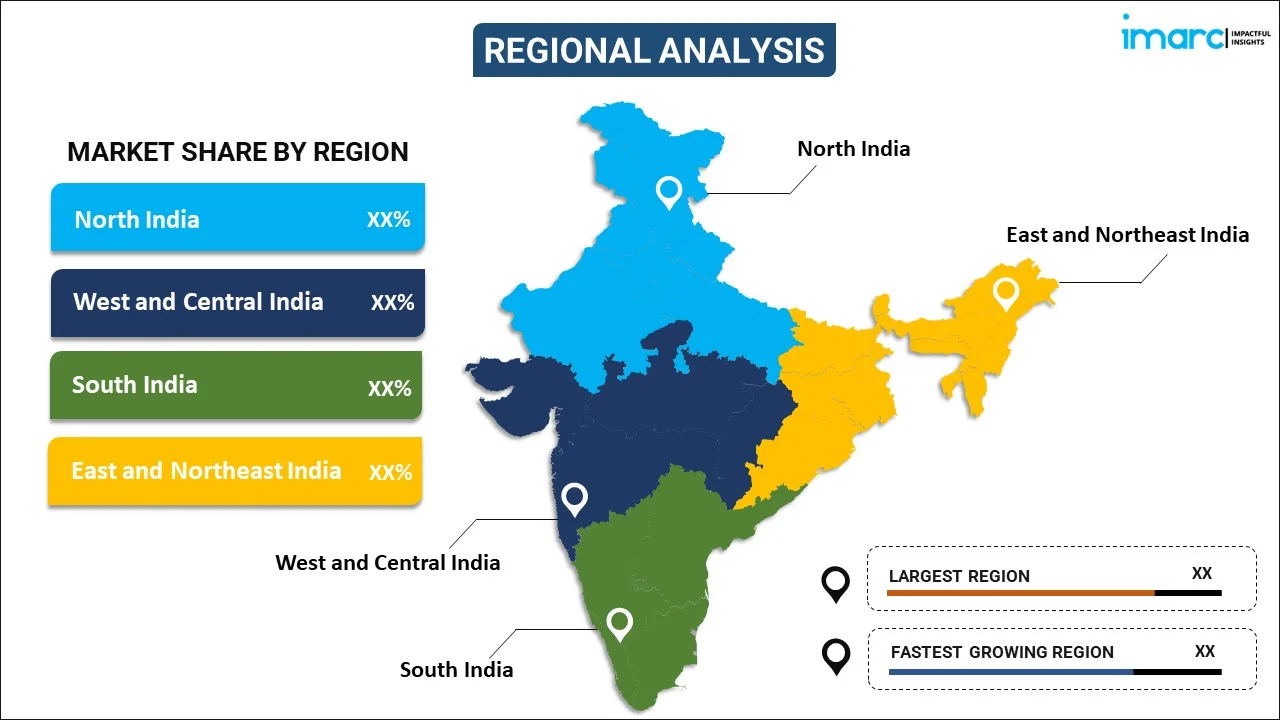
India Revenue Cycle Management Market Report by Type (Standalone, Integrated), Component (Software, Services), Deployment (Web-based, Cloud-based, On-premises), End User (Hospitals, Physicians, Diagnostic and Ambulatory Care Centers), and Region 2025-2033
Market Overview:
India revenue cycle management market size reached USD 4.8 Billion in 2024. Looking forward, IMARC Group expects the market to reach USD 15.0 Billion by 2033, exhibiting a growth rate (CAGR) of 12.6% during 2025-2033. The integration of advanced technologies, such as artificial intelligence, machine learning, and analytics, into revenue cycle management systems, which enhances efficiency, reduces errors, and improves the overall revenue cycle process, is driving the market.
|
Report Attribute
|
Key Statistics
|
|---|---|
|
Base Year
|
2024
|
|
Forecast Years
|
2025-2033
|
|
Historical Years
|
2019-2024
|
|
Market Size in 2024
|
USD 4.8 Billion |
|
Market Forecast in 2033
|
USD 15.0 Billion |
| Market Growth Rate 2025-2033 | 12.6% |
Revenue cycle management (RCM) refers to the strategic process that healthcare organizations use to manage the financial aspects of patient care throughout their lifecycle. It encompasses the entire patient journey, from scheduling appointments to the final payment collection. RCM involves various stages, including patient registration, insurance verification, coding and billing, claims submission, and payment reconciliation. The goal is to optimize revenue collection, minimize billing errors, and enhance overall financial performance. Efficient RCM systems streamline administrative tasks, improve billing accuracy, and reduce the reimbursement cycle, ensuring that healthcare providers receive timely and accurate compensation for their services. By integrating technology and best practices, healthcare organizations can enhance the efficiency of their financial processes, ultimately supporting better patient care and organizational sustainability.
India Revenue Cycle Management Market Trends:
The revenue cycle management market in India is witnessing robust growth, primarily driven by several key factors. Firstly, the increasing demand for streamlined financial processes in the healthcare sector has propelled the adoption of RCM solutions. These solutions offer healthcare organizations efficient tools to manage billing, claims processing, and payment collections, contributing to overall operational efficiency. Additionally, the growing prevalence of electronic health records (EHRs) has further fueled the demand for RCM solutions, as they seamlessly integrate with these systems, enhancing data accuracy and accessibility. Moreover, the ongoing digital transformation in the healthcare industry has spurred the adoption of advanced technologies such as artificial intelligence and machine learning within RCM solutions. These technologies play a pivotal role in automating tedious and error-prone tasks, reducing manual intervention, and ultimately improving the accuracy of financial transactions. Furthermore, the emphasis on regulatory compliance and the need for healthcare providers to navigate complex reimbursement structures are driving the adoption of RCM solutions that ensure adherence to evolving healthcare regulations. In conclusion, the RCM market in India is thriving, propelled by the convergence of technological innovation, increasing digitization, and the imperative for regulatory compliance in the healthcare sector.
India Revenue Cycle Management Market Segmentation:
IMARC Group provides an analysis of the key trends in each segment of the market, along with forecasts at the country level for 2025-2033. Our report has categorized the market based on type, component, deployment, and end user.
Type Insights:

- Standalone
- Integrated
The report has provided a detailed breakup and analysis of the market based on the type. This includes standalone and integrated.
Component Insights:
- Software
- Services
A detailed breakup and analysis of the market based on the component have also been provided in the report. This includes software and services.
Deployment Insights:
- Web-based
- Cloud-based
- On-premises
The report has provided a detailed breakup and analysis of the market based on the deployment. This includes web-based, cloud-based, and on-premises.
End User Insights:
- Hospitals
- Physicians
- Diagnostic and Ambulatory Care Centers
A detailed breakup and analysis of the market based on the end user have also been provided in the report. This includes hospitals, physicians, and diagnostic and ambulatory care centers.
Regional Insights:

- North India
- West and Central India
- South India
- East and Northeast India
The report has also provided a comprehensive analysis of all the major regional markets, which include North India, West and Central India, South India, and East and Northeast India.
Competitive Landscape:
The market research report has also provided a comprehensive analysis of the competitive landscape. Competitive analysis such as market structure, key player positioning, top winning strategies, competitive dashboard, and company evaluation quadrant has been covered in the report. Also, detailed profiles of all major companies have been provided.
India Revenue Cycle Management Market Report Coverage:
| Report Features | Details |
|---|---|
| Base Year of the Analysis | 2024 |
| Historical Period | 2019-2024 |
| Forecast Period | 2025-2033 |
| Units | Billion USD |
| Scope of the Report | Exploration of Historical Trends and Market Outlook, Industry Catalysts and Challenges, Segment-Wise Historical and Future Market Assessment:
|
| Types Covered | Standalone, Integrated |
| Components Covered | Software, Services |
| Deployments Covered | Web-based, Cloud-based, On-premises |
| End Users Covered | Hospitals, Physicians, Diagnostic and Ambulatory Care Centers |
| Regions Covered | North India, West and Central India, South India, East and Northeast India |
| Customization Scope | 10% Free Customization |
| Post-Sale Analyst Support | 10-12 Weeks |
| Delivery Format | PDF and Excel through Email (We can also provide the editable version of the report in PPT/Word format on special request) |
Key Questions Answered in This Report:
- How has the India revenue cycle management market performed so far and how will it perform in the coming years?
- What has been the impact of COVID-19 on the India revenue cycle management market?
- What is the breakup of the India revenue cycle management market on the basis of type?
- What is the breakup of the India revenue cycle management market on the basis of component?
- What is the breakup of the India revenue cycle management market on the basis of deployment?
- What is the breakup of the India revenue cycle management market on the basis of end user?
- What are the various stages in the value chain of the India revenue cycle management market?
- What are the key driving factors and challenges in the India revenue cycle management?
- What is the structure of the India revenue cycle management market and who are the key players?
- What is the degree of competition in the India revenue cycle management market?
Key Benefits for Stakeholders:
- IMARC’s industry report offers a comprehensive quantitative analysis of various market segments, historical and current market trends, market forecasts, and dynamics of the India revenue cycle management market from 2019-2033.
- The research report provides the latest information on the market drivers, challenges, and opportunities in the India revenue cycle management market.
- Porter's five forces analysis assist stakeholders in assessing the impact of new entrants, competitive rivalry, supplier power, buyer power, and the threat of substitution. It helps stakeholders to analyze the level of competition within the India revenue cycle management industry and its attractiveness.
- Competitive landscape allows stakeholders to understand their competitive environment and provides an insight into the current positions of key players in the market.
Need more help?
- Speak to our experienced analysts for insights on the current market scenarios.
- Include additional segments and countries to customize the report as per your requirement.
- Gain an unparalleled competitive advantage in your domain by understanding how to utilize the report and positively impacting your operations and revenue.
- For further assistance, please connect with our analysts.
 Inquire Before Buying
Inquire Before Buying
 Speak to an Analyst
Speak to an Analyst
 Request Brochure
Request Brochure
 Request Customization
Request Customization




.webp)




.webp)












